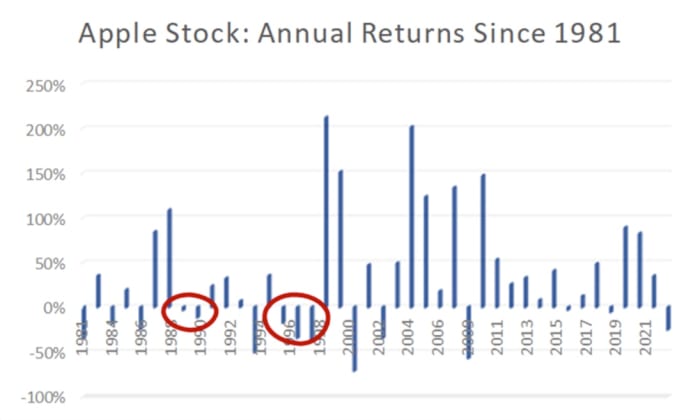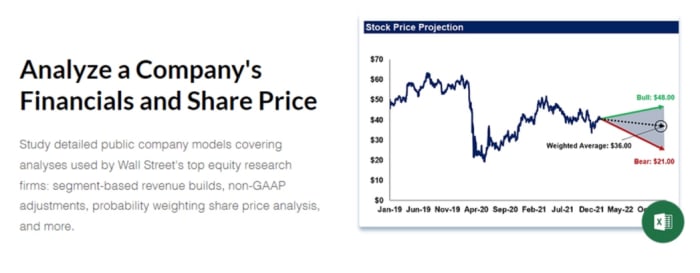- So far in 2022, Apple stock (AAPL) – Get Free Report has had the fourth worst year of returns of the past two-plus decades – a period that includes three massive bear markets.
- But as we have discussed on this channel a few times before, the best time to buy AAPL is when shares are substantially down relative to all-time highs, which is the case now.
- Could a pitiful year of performance in 2022 be a sign that Apple stock investors will smile widely in 2023? I look at the historical data to find out.
(Read more from the Apple Maven: Apple Stock Down 52% In One Day: When And Why It Happened)
AAPL’s Winning Streak Is Over
As I have recently noted, Apple stock has been a beast at producing wealth over the past four decades. A mere $1,000 invested in 1982 would have been worth over $1 million today.
A less-known fact about the stock is that AAPL has consistently delivered positive returns since the end of the Great Recession of 2008. Two years of (minimal) losses in 2015 and 2018 broke what could have been a winning streak of 13 consecutive years of gains.
More than a decade of nothing but bullishness ended abruptly in 2022. Apple stock is on track to produce losses of 25% this year, the worst that investors have seen since 2008. See the chart below.
Apple Stock: Will Losers Be Winners Next?
The better news is that losses can open a window of opportunity for investors looking to buy shares for cheaper. This is the key pillar in “the best strategy” for investing in Apple stock: accumulate shares after dips of 15% or more to produce about 5 percentage points in additional returns over the following 12 months, on average.
But of course, making money in the markets is not that simple. There is no guarantee that AAPL’s bad year of performance in 2022 will be followed by a year of lavish gains.
But wait: don’t investors get better returns when they buy Apple stock on weakness? Historically, this is true, on average. But it isn’t always the case.
Let me start with the average. Since 1981, Apple stock has produced average annual gains of 33.9%, which is quite impressive. The median, which helps to smooth out performance by ignoring positive and negative outliers, has been 24.5% per year.
But considering only the years following negative annual returns, AAPL has produced much better average gains of 47.9%! The median has been 35.1%. In either case, we are looking at returns that are at least 10 percentage points better than average following a year of loss.
But now, look at the chart below. Pay special attention to the cluster of losses in the late 1980s and mid-1990s, circled in red.
- After dropping 3% in 1988, AAPL lost another 12% in 1989.
- After dropping 17% in 1995, AAPL lost another 35% in 1996, and then yet another 37% in 1997.
To be fair, the back-to-back losses mentioned above have happened around very unique circumstances.
In 1989, a much younger Apple had been a publicly-traded company for less than a decade. Its “fifty-five or die” strategy of aggressive pricing and rich margins proved unsuccessful and led to declining sales in that year’s holiday season.
The mid-1990s was a particularly turbulent period for Apple. Suffice it to say that the company nearly went bankrupt back then, and only the return of Steve Jobs as CEO in 1997 saved it from going under. It is not a surprise that Apple stock suffered as much as it did.
Since 1998, never has a negative year of returns for AAPL been followed by another year of losses. At worst, in 2016, Apple shares climbed “only” 12% after being down 3% in 2015. At best, AAPL jumped 212% in 1998 (and then another 151% in 1999) as the company rose from the ashes – and the stock benefited from the inflation of the tech bubble.
The Key Takeaway
If history can be used as a reference, there is a decent chance that Apple stock’s pitiful 2022 performance will be followed by a much better 2023. But investors should not be overly confident. Back-to-back losses have happened before, and the same could happen again.
Ask Twitter
2022 is shaping up to be a bad year for Apple stock. But since 1998, AAPL has not produced losses two years in a row. What do you think happens to the share price next year?
Land a Top Equity Research Job with Peak Frameworks
Equity research is a great career that combines deep industry analysis, financial modeling, and strategic thinking to make money in the stock market.
Many students have used the Peak Frameworks Equity Research course to break into the industry out of school, or to transition into the field from a non-finance career path. Learn from an instructor with years of experience at Goldman Sachs and J.P. Morgan.
Click on this link to learn more and use the code APPLEMAVEN10 for 10% off the course.
(Disclaimers: this is not investment advice. The author may be long one or more stocks mentioned in this report. Also, the article may contain affiliate links. These partnerships do not influence editorial content. Thanks for supporting the Apple Maven)








